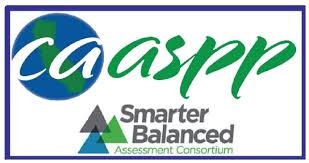Summative Data
The goal of summative assessment is to evaluate student learning at the end of an instructional period by comparing it against a standard or benchmark. States and districts frequently use summative data to evaluate instruction programs, gauge progress, and analyze demographic trends to improve student learning. This page lists common metrics used to gather summative data among schools in Sonoma County.
California Assessment of Student Progress and Performance (CAASPPP)
The primary purpose of the California Assessment of Student Performance and Progress (CAASPP) System is to assist teachers, administrators, students, and parents by promoting high-quality teaching and learning through the use of a variety of assessment approaches and item types. The CAASPP includes the Smarter Balanced assessment system for English language arts/literacy (ELA) and mathematics, the California Science Test (CAST), the California Alternate Assessments (CAAs) for ELA, mathematics, and science, and the optional California Spanish Assessment (CSA). The California Department of Education provides access to results for all counties, districts, and schools here. Results can be disaggregated by grade, subject, and significant school subgroups.
Smarter Balanced Assessment Consortium
California uses annual measures from the Smarter Balanced Assessment Consortium to evaluate English language arts and mathematics learning for students in grades 3 through 8 and 11. Descriptions of the knowledge, skills, and processes that are demonstrated by students with this assessment are described at the California Department of Education website.
 2017 SBAC /CAASPP Results | Link
2017 SBAC /CAASPP Results | Link
This page from Ed Source provides an easy way of seeing CAASPP results alongside results from previous years for the Smarter Balanced Assessments in English language arts (ELA) and mathematics.
California Science Test (CAST)
The statewide California Assessment of Student Performance and Progress (CAASPP) System includes federally required science assessments in grades five and eight and once in high school (i.e., grade ten, eleven, or twelve). Since the adoption of the Next Generation Science Standards for California Public Schools, Kindergarten Through Grade Twelve (CA NGSS) in 2013, the California Department of Education developed the California Science Test (CAST), which is aligned with these standards.
High school students will have only one opportunity to take a science test (i.e., in grade ten, eleven, or twelve). Local educational agencies (LEAs) can elect to administer a science test to students in grade ten or eleven. Students in grade twelve, who have not yet taken a science test, will automatically be registered to test. Students repeating grade twelve are not eligible to test.
English Language Proficiency Assessments for California (ELPAC)
The English Language Proficiency Assessments for California (ELPAC) is the required state test for English language proficiency (ELP) that must be given to students whose primary language is a language other than English. State and federal law require that local educational agencies administer a state test of ELP to eligible students in kindergarten through grade twelve. The California Department of Education (CDE) transitioned from the California English Language Development Test (CELDT) to the ELPAC as the state ELP assessment in 2018. The ELPAC is aligned with the 2012 California English Language Development Standards. It consists of two separate ELP assessments: one for the initial identification of students as English learners (ELs), and a second for the annual summative assessment to measure a student’s progress in learning English and to identify the student's level of ELP.
Overview video English
Overview video Spanish

